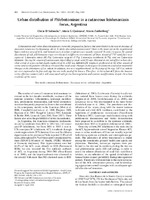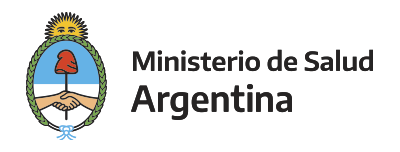Please use this identifier to cite or link to this item:
http://sgc.anlis.gob.ar/handle/123456789/253| DC Field | Value | Language |
|---|---|---|
| dc.contributor.author | Salomón, Oscar Daniel | es |
| dc.contributor.author | Quintana, María Gabriela | es |
| dc.contributor.author | Zaidenberg, Mario | es |
| dc.date.accessioned | 2012-10-22T14:14:17Z | - |
| dc.date.available | 2012-10-22T14:14:17Z | - |
| dc.date.issued | 2008-05 | - |
| dc.identifier.issn | 1678-8060 | - |
| dc.identifier.uri | http://sgc.anlis.gob.ar/handle/123456789/253 | - |
| dc.identifier.uri | http://www.scielo.br/pdf/mioc/v103n3/270.pdf | - |
| dc.description | Fil: Salomón, Oscar Daniel. ANLIS Dr.C.G.Malbrán. Centro Nacional de Diagnóstico e Investigación en Endemo-Epidemias; Argentina. | es |
| dc.description | Fil: Quintana, María Gabriela. Universidad Nacional de Tucumán. Instituto Superior de Entomología Dr Abraham Willink; Argentina. | es |
| dc.description | Fil: Zaidenberg, Mario. Coordinación Nacional de Vectores. Delegación Salta; Argentina. | es |
| dc.description.abstract | Urbanization and vector domestication are currently proposed as factors that contributed to the recent increase of American cutaneous leishmaniasis (ACL). Is likely also urban transmission? Oran is the main city in theArgentinean hyper-endemic area of ACL, and human cases in urban residences are usually reported. In order to assess the spatial distribution of risk, phlebotomine traps were located in different environments of Oran. A total of 7,787 sand flies were captured: Lutzomyia neivai(98.1%), Lutzomyia migonei (1.2%), Lutzomyia cortelezzii(0.7%), and one Lutzomyia shannoni. During the season of transmission (April-May) a single sand fly was obtained in one out of five urban sites, while a trap in a peri-urban pigsty captured up to 2,985 Lu. neivai/night. Captures performed in the other season of vector activity (September-October) revealed that small-scale changes in the pigsty environment resulted in noticeable changes in the abundance of Lu. neivai. In addition, in a new neighbourhood, on the fringe of the city, 1,073 Lu. neivai/ site were captured in the forested edge but one in the yard of the houses. Therefore, in this urban ACL focus the human-vector effective contact risk is still associated with peri-urban vegetation and ecotone modifications despite the urban residence of the cases. | es |
| dc.format | application/pdf | ES |
| dc.language.iso | en | es |
| dc.relation.ispartof | Memorias do Instituto Oswaldo Cruz | es |
| dc.rights | info:eu-repo/semantics/openAccess | en_US |
| dc.rights | Creative Commons Attribution 3.0 International License | - |
| dc.rights.uri | https://creativecommons.org/licenses/by/3.0/deed.es | - |
| dc.source | Memórias do Instituto Oswaldo Cruz, 2008, 103(3), 282–287. | en_US |
| dc.subject | Psychodidae | es |
| dc.subject | Leishmaniasis Cutánea | es |
| dc.subject | Argentina | es |
| dc.title | Urban distribution of Phlebotominae in a cutaneous leishmaniasis focus, Argentina | es |
| dc.type | Artículo | es |
| dc.coverage | ARG | en_US |
| anlis.essnrd | 1 | es |
| item.grantfulltext | open | - |
| item.fulltext | With Fulltext | - |
| item.openairetype | Artículo | - |
| item.openairecristype | http://purl.org/coar/resource_type/c_18cf | - |
| item.languageiso639-1 | en | - |
| item.cerifentitytype | Publications | - |
| crisitem.author.dept | Administración Nacional de Laboratorios e Institutos de Salud “Dr. Carlos G. Malbrán” (ANLIS) | - |
| crisitem.author.dept | Instituto Nacional de Medicina Tropical (INMeT) | - |
| crisitem.author.dept | Administración Nacional de Laboratorios e Institutos de Salud “Dr. Carlos G. Malbrán” (ANLIS) | - |
| crisitem.author.dept | Instituto Nacional de Medicina Tropical (INMeT) | - |
| crisitem.author.parentorg | Administración Nacional de Laboratorios e Institutos de Salud “Dr. Carlos G. Malbrán” (ANLIS) | - |
| crisitem.author.parentorg | Administración Nacional de Laboratorios e Institutos de Salud “Dr. Carlos G. Malbrán” (ANLIS) | - |
| Appears in Collections: | snrd Publicaciones CeNDIE | |
Files in This Item:
| File | Description | Size | Format | |
|---|---|---|---|---|
| MemóriasdoInstitutoOswaldoCruz,2008,103(3),282–287.pdf | 608.84 kB | Adobe PDF |  View/Open |
Page view(s)
152
checked on Dec 17, 2025
Download(s)
81
checked on Dec 17, 2025
Google ScholarTM
Check
This item is licensed under a Creative Commons License


